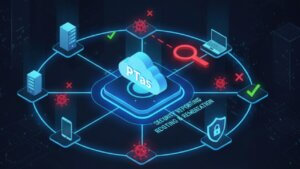Cybersecurity threats are often associated with external attackers, such as hackers and cybercriminal organizations. However, one of the most significant risks to an organization comes from within—its employees. Insider threats can be intentional or unintentional, and they pose a serious security risk to businesses of all sizes. This blog explores the nature of insider threats, how they occur, and what organizations can do to mitigate them.
Understanding Insider Threats
An insider threat arises when an individual within an organization, such as an employee, contractor, or business partner, misuses their access to harm the company. These threats are categorized into three main types:
Malicious Insiders: Employees or associates who deliberately steal data, sabotage systems, or engage in fraud for personal gain or revenge.
Negligent Insiders: Employees who unintentionally expose the company to cyber risks due to carelessness, such as falling for phishing scams or mishandling sensitive data.
Compromised Insiders: Employees whose accounts or credentials have been hijacked by cybercriminals, making them an unwitting threat to the organization.

Common Ways Insider Threats Occur
Insider threats can manifest in various ways, including:
1. Data Theft and Espionage
Employees with access to sensitive data may steal company secrets, customer information, or financial records.
Competitors or nation-state actors may recruit insiders to conduct corporate espionage.
2. Accidental Data Exposure
Sending sensitive emails to the wrong recipient.
Storing confidential files on unsecured cloud services or personal devices.
Misconfiguring security settings on databases and applications.
3. Credential Theft and Unauthorized Access
Weak or reused passwords can be exploited by cybercriminals.
Employees may inadvertently grant access to malicious actors by clicking on phishing emails or social engineering tactics.
4. Sabotage and Disruptive Actions
Disgruntled employees may delete or alter critical files.
Some insiders plant malware or disrupt operations as revenge for perceived workplace injustices.
Consequences of Insider Threats
Insider threats can lead to severe financial, legal, and reputational damage. Some potential consequences include:
Financial Losses: Data breaches and cyber incidents caused by insiders can result in millions of dollars in damages.
Regulatory Penalties: Non-compliance with data protection laws due to insider negligence can lead to heavy fines.
Reputation Damage: Leaked customer or business data can harm trust and credibility.
Operational Disruptions: Insider-led cyber incidents can halt business operations, leading to significant downtime and productivity loss.

Here is an X post on a phishing attack, showing just how dangerous and realistic phishing scams can be.
How to Defend Against Insider Threats
Organizations must adopt a proactive approach to mitigating insider threats. Here are key strategies to reduce the risk:
1. Implement Strict Access Controls
Use the principle of least privilege (PoLP) to ensure employees only have access to the data necessary for their roles.
Regularly review and update access permissions.
2. Conduct Employee Training and Awareness Programs
Educate employees on cybersecurity best practices, phishing awareness, and data handling policies.
Encourage a culture of security where employees report suspicious activities.
3. Monitor and Audit User Activity
Implement user activity monitoring (UAM) tools to detect unusual behavior.
Use Security Information and Event Management (SIEM) systems to analyze insider threats in real time.
4. Implement Multi-Factor Authentication (MFA)
Require MFA for all critical systems and sensitive data access.
Reduce the risk of credential theft and unauthorized access.
5. Enforce Data Loss Prevention (DLP) Policies
Use DLP solutions to monitor and restrict unauthorized data transfers.
Block employees from copying sensitive data to external devices or cloud storage.
6. Establish Insider Threat Response Plans
Develop a clear response strategy for handling insider threats.
Conduct periodic drills to test and refine incident response capabilities.
7. Foster a Positive Work Environment
Address employee grievances to reduce the likelihood of malicious actions.
Encourage open communication and transparency within the organization.
Conclusion
Insider threats pose one of the most significant cybersecurity risks to organizations. Whether through malicious intent, negligence, or compromised credentials, insiders can cause severe damage to a company’s security and operations. By implementing strict security measures, monitoring user behavior, and fostering a culture of cybersecurity awareness, businesses can minimize the risks associated with insider threats. Proactive defense strategies and a well-prepared incident response plan are essential for safeguarding an organization from threats that originate from within.
Why Businesses Trust SecureMyOrg for Comprehensive Network Security
At SecureMyOrg, we uncover and fix all possible security vulnerabilities of mobile and web, while providing solutions to mitigate risks. We are trusted by renowned companies like Yahoo, Gojek and Rippling, and with 100% client satisfaction, you’re in safe hands!







Some of the things people reach out to us for –
- Building their cybersecurity program from scratch – setting up cloud security using cost-effective tools, SIEM for alert monitoring, building policies for the company
- Vulnerability Assessment and Penetration Testing ( VAPT ) – We have certified professionals, with certifications like OSCP, CREST – CPSA & CRT, CKA and CKS
- DevSecOps consulting
- Red Teaming activity
- Regular security audits, before product release
- Full time security engineers.
Relevant Posts

What Is Penetration Testing as a Service?
Penetration testing as a service (PTaaS) lets experts simulate real attacks to uncover vulnerabilities before hackers do. This guide explains the process, benefits, and costs, helping businesses strengthen defenses with predictable, ongoing security checks.

How To Inspect Encrypted Traffic Without Breaking Privacy
Network administrators face a challenge: securing systems while respecting privacy. This guide explains how to inspect encrypted traffic without breaking privacy using metadata, anomaly detection, and machine learning ensuring visibility, compliance, and trust.

How to Audit Infrastructure as Code (IaC) for Security Vulnerabilities
Discover how to audit Infrastructure as Code (IaC) for security vulnerabilities with this practical guide. Learn to scan IaC files using tools like Checkov, fix issues like exposed resources, and integrate audits into CI/CD pipelines. Protect your cloud systems from misconfigurations and ensure compliance with clear, actionable steps.

DevSecOps Best Practices: Integrating Security Early in Your CI/CD Pipeline
This article provides a practical guide to embedding security into every stage of your CI/CD pipeline. Learn core DevSecOps best practices like SAST, DAST, dependency scanning, secrets management, and compliance automation to catch vulnerabilities early, foster a culture of shared ownership, and build a secure-by-design development process that accelerates release cycles.

5 Cloud Misconfigurations That Lead to Data Breaches
Cloud misconfigurations are one of the leading causes of data breaches, yet they’re also among the most preventable. From exposed storage buckets to weak IAM policies, attackers exploit these mistakes daily. Learn about the top 5 misconfigurations and how your organization can fix them before they lead to costly data exposure.

How Can Ethical Hacking Training Elevate Your Internal Cybersecurity?
Ethical hacking training empowers organizations to strengthen internal cybersecurity by uncovering vulnerabilities before attackers do. From mastering penetration testing to enhancing incident response, this training builds a proactive security culture. Learn how Secure My ORG’s programs can elevate your team’s skills and fortify defenses against modern threats like AI-driven attacks.
